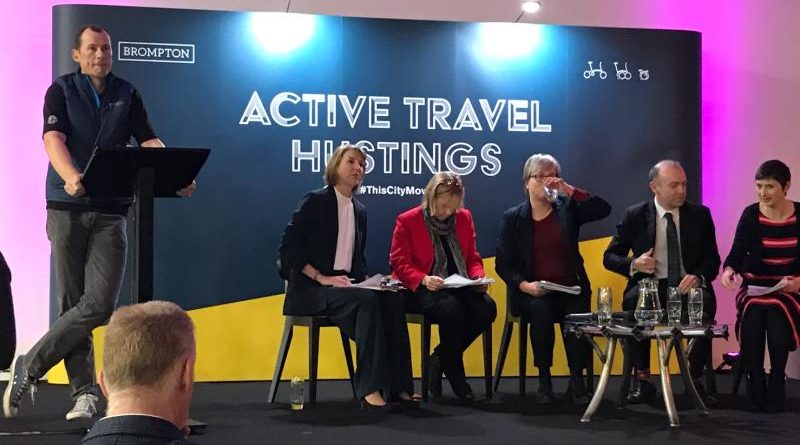Watch: Brompton’s Active Travel hustings with four key political parties
Last night Brompton hosted a special hustings on the topic of active travel which, as part of the wider mix of climate and transport issues, has become a political hot potato in its own right in recent years.
Chaired by Rachel Schofield – a BBC presenter with access to a bike bell tacked on to the lectern should speeches run over – the event was put on in order that representatives with inside knowledge might expand upon their manifesto commitments in greater detail.
Should you have roughly 80 minutes spare today, we’ve embedded the hustings below, which took place with representatives from four of the UK’s main political parties. The panel included:
Conservative Party
Represented by Chris Heaton Harris the Cycling and Walking minister currently in Government.
Key quotes
“£350 Million pounds is our commitment for cycling infrastructure alone, that’s £70 Million a year for the next Parliament; which would be transformative. That would allow communities to build proper safe bike lanes.”
Analysis
Heaton-Harris has our calculator out again, so let’s look at the numbers with some context.
Going by the £29 billion 2016-2017 spend for the UK transport budget, the proposed spend on safe infrastructure is just 0.24% of the transport budget of many years ago and roughly £1.05 per head spent per person of the UK population. This, far from being “transformative” is actually a decline in spend on current levels. When pressed on further commitment by Cycling UK, Heaton-Harris refused to budge toward the 5% of budget called for by the cycling org.
Furthermore, it is said that top-level safe segregated infrastructure for cycling – the kind you’d happily let children cycle on – costs roughly £1.45 million per kilometre.
By that offer, this means that in the best case scenario the Conservative Government are allowing for just over 241 kilometres of safe cycle path to be laid each year nationally; roughly the distance of one straight route spanning London to Chesterfield.
Labour Party 
Represented by Ruth Cadbury, a member of the Transport Select Committee and co-chair of the All Party Parliamentary Cycling Group
Key quotes
“The cost of not providing for active travel is too high; the cost to health, to our children’s health, the cost economically of congestion, the viability of town and city centres and now, much further up the agenda, is the climate emergency.”
“Labour’s Healthy Streets programme aims to double the number of cycle journeys taken, particularly in England. Four essential elements include redesigned streets, an infrastructure that provides safe traffic free cycling, training support, access to bikes for those who cannot afford to buy new.
“We have a commitment to 5,000 kilometres of new cycleways, universal access to affordable bikes, grants and loans for electric bikes and really rolling out cycle training to children and adults.”
Analysis
5,000 kilometres is quite a claim and would certainly transform a swathe of the country. However, cycling infrastructure differs vastly in quality, ranging painted roads to fully separated infrastructure. Again, rough costings for these cost anywhere between £240,000 and £1.45 million per kilometre. For context, 5,000 kilometres lays cycle path there and back between London and Bucharest in Romania.
Therefore, some reverse engineering of the maths gives us a spend estimate of anywhere between £1.2 billion for low quality infrastructure and £7.25 billion for safe and segregated. The latter figure is roughly what’s quoted in the manifesto for cycling.
Labour has, quite notably, committed the largest spend per head at £50 within its first term. In year one we are told to expect £2.5 billion (8.6% of transport budget) ramping up throughout the Parliamentary term to reach £4.7 billion.
There is also a pledge to bring back axed quango Cycling England to oversee progress.
Liberal Democrats
Represented by Caroline Pidgeon, deputy chair of the Transport Committee, with special interest in cycle hire and safety.
Key quotes
“The Liberal Democrats plan to increase spending five fold to reach ten percent of the transport budget. We need changes in our planning process and measures to reduce car dependency; reducing diesel vehicles in particular.”
“Liberal Democrats recognise that it’s vital to keeping people healthy and so we seek to make it accessible to everyone. We would put walking and cycling at the centre of our transport policy, as opposed to an afterthought.”
Analysis
Offering up 10% of the transport budget for active travel is equivalent to putting up £2.9 billion annually, which equates to around 2,000 kilometres of safe cycling infrastructure. by comparison, that’ll lay a line between London and Naples, Italy with cycling infrastructure. It is also worth a quite startling £43.67 per head of the UK population.
Green Party
Represented by “everyday cyclist” Caroline Russell, the national spokesperson for the green party on transport and the chair of the assembly’s environment committee.
Key quotes
“Our manifesto is a full response to the climate emergency, we seek to cut the car dependency in our transport system. We seek to take walking and cycling seriously. We need to make good quality conditions, money to make it happen, commitment and leadership to put it through and to stop bad projects that induce more traffic.”
“We’ve put aside £25 billion across ten years for walking and cycling, with priority to make main roads where people live less hostile. In practice this will ramp up over the ten years, we will need a new cycling body much like Cycling England.”
“We will have a national vision zero policy linked to enforcement.”
Analysis
There’s quite a bit beyond the budget committed, according to Russell, but to keep comparison apples to apples, here’s the budget broken down.
At £25 billion over ten years we are told to expect around £2.5 billion a year spent, albeit ramping up toward the end of the second term.
£2.5 billion is approximately 8.6% of the aforementioned transport budget and, by current standards, a vastly improved offer representing £37.65 per head of the population for active travel.
The sum is enough to lay over 1,724 kilometres of top-level safe cycling infrastructure; roughly the distance from London to Budapest in Hungary.
Lead image: Laurence Boon



